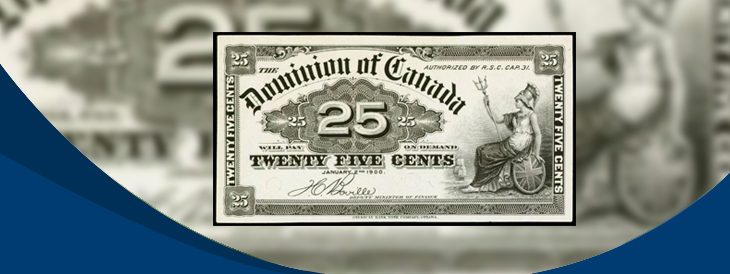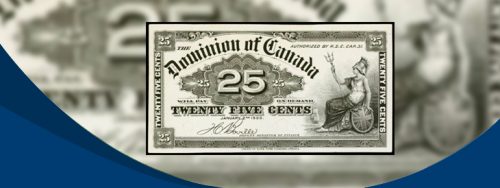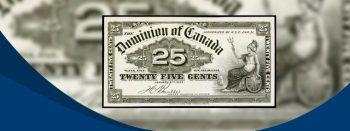Last updated on May 2nd, 2024 at 03:34 pm
Last Updated on May 2, 2024 Posted by Colonial Acres Coins
Canada’s physical currency has a rather unique history much like the great nation itself. One of the interesting things about Canada’s history of currency is the use of two official notes, the Dominion of Canada banknotes and the Chartered banknotes. The 25 cents Dominion of Canada note stands out as a very interesting collector’s item.
Dominion vs Charter? Canadian Note History at a Glance
During the years 1870-1935, the main currencies in circulation were the ones released by Dominion. Alongside the dominion banknotes were chartered banknotes, which were issued on a regional basis. After 1935 the Bank of Canada took over the role of note-issuing and the production of dominion notes ceased. The end of production converted these notes into treasured collectibles over time.
Some dominion notes have transitioned to the world of priceless collectibles, but others haven’t. The savvy collector must be able to distinguish between the two. The more common banknotes available to collectors are in denominations smaller than five dollars. Notes with higher face value are typically rarer. Avid collectors of the Dominion of Canada notes know that there are twenty designs which are considered worthy of collecting.
The 25 Cents Note
The 25 Cents Dominion of Canada note is also known as a shinplaster and is one of the fractional notes attracting much attention among avid collectors. Determining whether a note of this kind is worthy of being collected is quite a complicated task. The value of your 25 cents Canadian bank note is dependent on a few factors. These include its design, age, and condition.
Look out for one of the three designs that were featured on these notes during different time periods.
The March 1st, 1870 25 Cents Dominion of Canada Bill
This note is identified by a greenback with the inscription ‘Redeemable on Presentation at Montreal, Toronto or St John’. On the other side, you’ll find a picture of Britannia. 4,300,000 of these notes were released as a temporary measure to stem the in
The January 2nd Dominion of Canada 25 cents note
This note as a redesigned version of its 1870 predecessor. To identify this note as distinct from its predecessor, look out for a seated Britannia as well as a brownish hue on the notes. Like the 1870 version, the back of this note is green. These notes bear the signature of one of three men; T. C. Boville, J.M. Courtney or J.C. Saunders. Notes signed by Saunders are especially rare but despite this, all three notes typically attract the same value (as long as their conditions are equal).
The July 2nd, 1923 Dominion of Canada 25 Cents Note
Of the three notes, this one is the most common which is very understandable since seven million of them were issued. To identify this 25 cent note, look for red serial numbers, a light bronze hue and Britannia holding a trident. They feature one of four authorizing signatures, J.C. Saunders, C. E. Campbell, W. C. Clarke or Geo W. Handyman. Those signed by Handyman attract more value since they tend to be priced at 75% higher figures than their counterparts.
Today, these notes are well s




